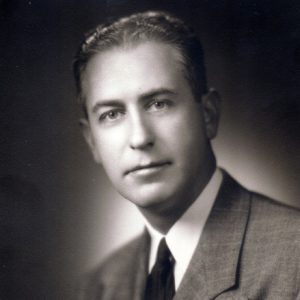calsfoundation@cals.org
Richard Colburn Butler Sr. (1910–1999)
Richard Colburn Butler Sr. was a lawyer, banker, real estate investor, philanthropist, and horticulturist who is best remembered for his wide variety of business developments and community activities. As the attorney for the Little Rock School Board, he played a major role in the 1957 Little Rock school desegregation crisis.
Richard Butler, the fourth child of Edna M. Clok and Richard Colburn Butler Sr., was born in Little Rock (Pulaski County) on January 1, 1910. (Butler, technically “Richard Butler Jr.,” referred to himself as “senior” after his father passed away.) His father was a real estate developer. Butler attended public school in Little Rock and then graduated from Little Rock Junior College in 1929. He subsequently enrolled in the University of Arkansas (UA) in Fayetteville (Washington County) and received his BA degree in 1931. Butler then entered law school but left before graduation due to business demands upon the death of his father in 1933. That same year, Butler passed the bar exam and began practicing law with the firm of House, Moses, and Holmes.
On March 7, 1936, he married Gertrude Marjorie Remmel, and they had one child, Richard Colburn Butler III, who was born on September 21, 1937. During World War II, Butler served in the U.S. Army Air Corps in the China-Burma-India Theater, where he won the Bronze Star. After the war, he returned to his law practice, where he remained until 1963.
Butler’s most famous work as an attorney began in 1956 when he was one of several lawyers retained by the Little Rock School Board to defend the district against a suit filed by the local chapter of the National Association for the Advancement of Colored People (NAACP). The suit, Cooper v. Aaron, asked the federal court to set aside the plans of the district to extend the time for desegregation and to proceed forthwith with integration. The case was eventually appealed to the U.S. Supreme Court, where, in August 1958, Butler argued that the school board had tried to carry out the order of the federal court in the 1954 Brown v. Board of Education of Topeka, Kansas decision but that their first goal was to maintain a viable public school, which would be impossible were they forced to desegregate immediately and completely. Butler argued that the board was simply asking for “patience and time.” The justices, deliberating less than thirty minutes, ruled that the board must proceed to desegregate immediately.
Butler continued to practice law after the Little Rock desegregation crisis, and like his father, who was a real estate developer, he gradually purchased pieces of land in and around Little Rock. Some of those parcels were eventually assembled to create both the River Ridge and Treasure Hills subdivisions.
In 1962, Butler joined the Board of Directors of the Commercial National Bank, and the following year, the board chairman, Ross Anderson, asked him to become the president. Butler gave up his law practice and assumed the presidency of the bank in 1963. He served as president until 1968, when he became chairman of the board, a position he held until 1981. Under his leadership, Commercial National Bank became one of the state’s largest financial institutions. He convinced Bill Bowen to leave his law practice and join the leadership of Commercial National Bank. Later, Butler and Bowen disagreed on the future of the bank, and Butler left in 1981.
After leaving the bank, Butler continued actively to manage his real estate and other financial interests, but he found more time to pursue his two avocations—horticulture and philanthropy. Butler had become interested in horticulture in the 1950s, and he excelled in hybridizing irises and daylilies. He gave freely of his stock, and many Little Rock gardens contain excellent examples of his plants.
As a philanthropist, Butler helped create Arkansas’s United Methodist Foundation. In addition, he supported many local organizations, such as the First Methodist Church, the University of Arkansas at Little Rock (UA Little Rock), the Little Rock Boys Club, Hendrix College, Wildwood Park for the Performing Arts, and the Central Arkansas Library System (CALS). In 1997, the library named its Arkansas history and genealogy department the Butler Center for Arkansas Studies in his honor.
By 1999, Butler’s health was failing. Determined never to become an invalid, Butler committed suicide on September 13, 1999. He is buried in Mount Holly Cemetery in Little Rock.
For additional information:
Caillouet, Linda S. “LR Native, Businessman Jumps from I-430 Bridge.” Arkansas Democrat-Gazette, September 14, 1999, pp. 1A, 5A.
Jacoway, Elizabeth. “Richard C. Butler and the Little Rock School Board: The Quest to Maintain ‘Educational Quality.’” Arkansas Historical Quarterly 65 (Spring 2006): 24–38.
Obituary of Richard Colburn Butler. Arkansas Democrat-Gazette, September 15, 1999, p. 5B.
Richard C. Butler Sr. Papers. Butler Center for Arkansas Studies. Central Arkansas Library System, Little Rock, Arkansas.
Bobby Roberts
Central Arkansas Library System






Comments
No comments on this entry yet.